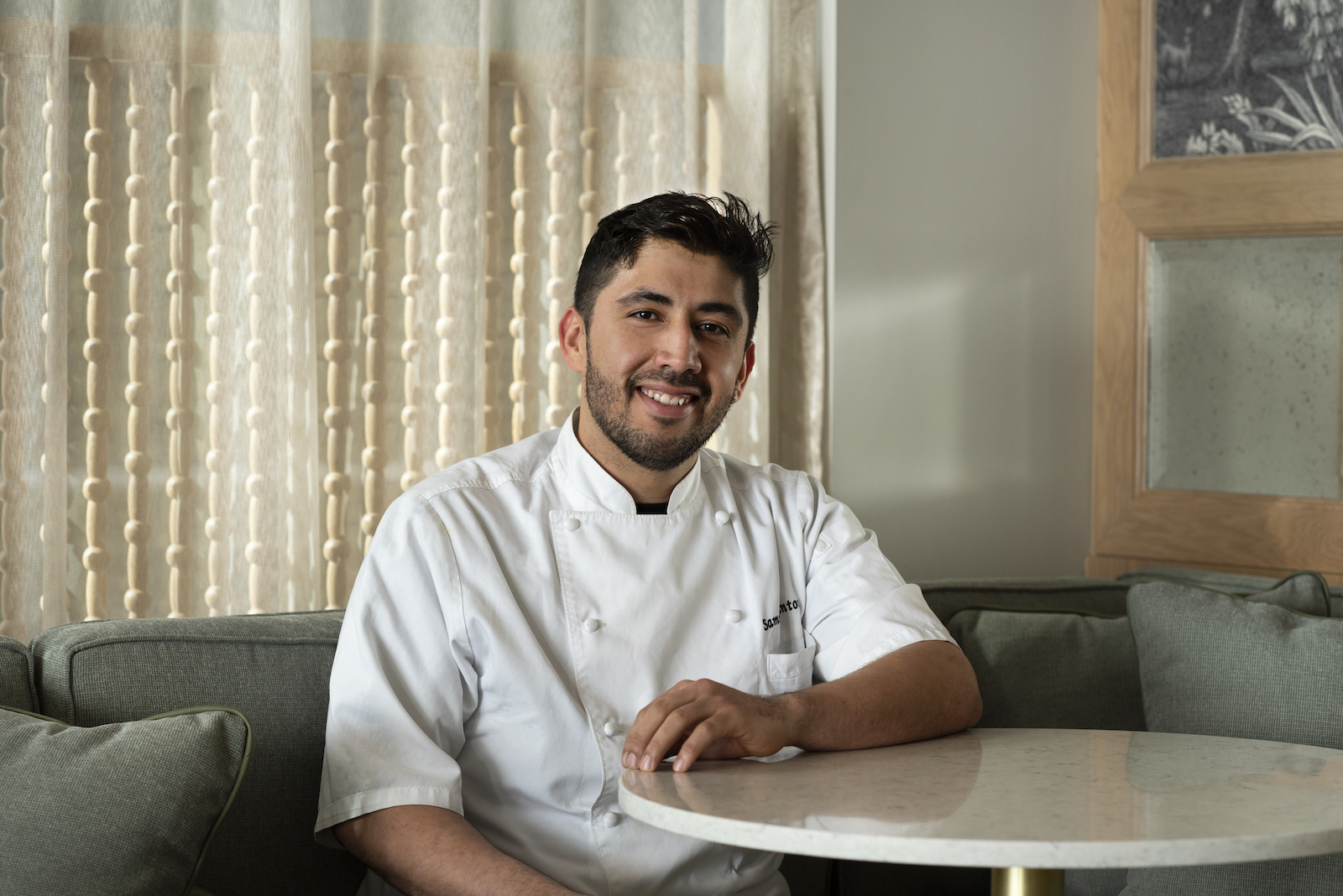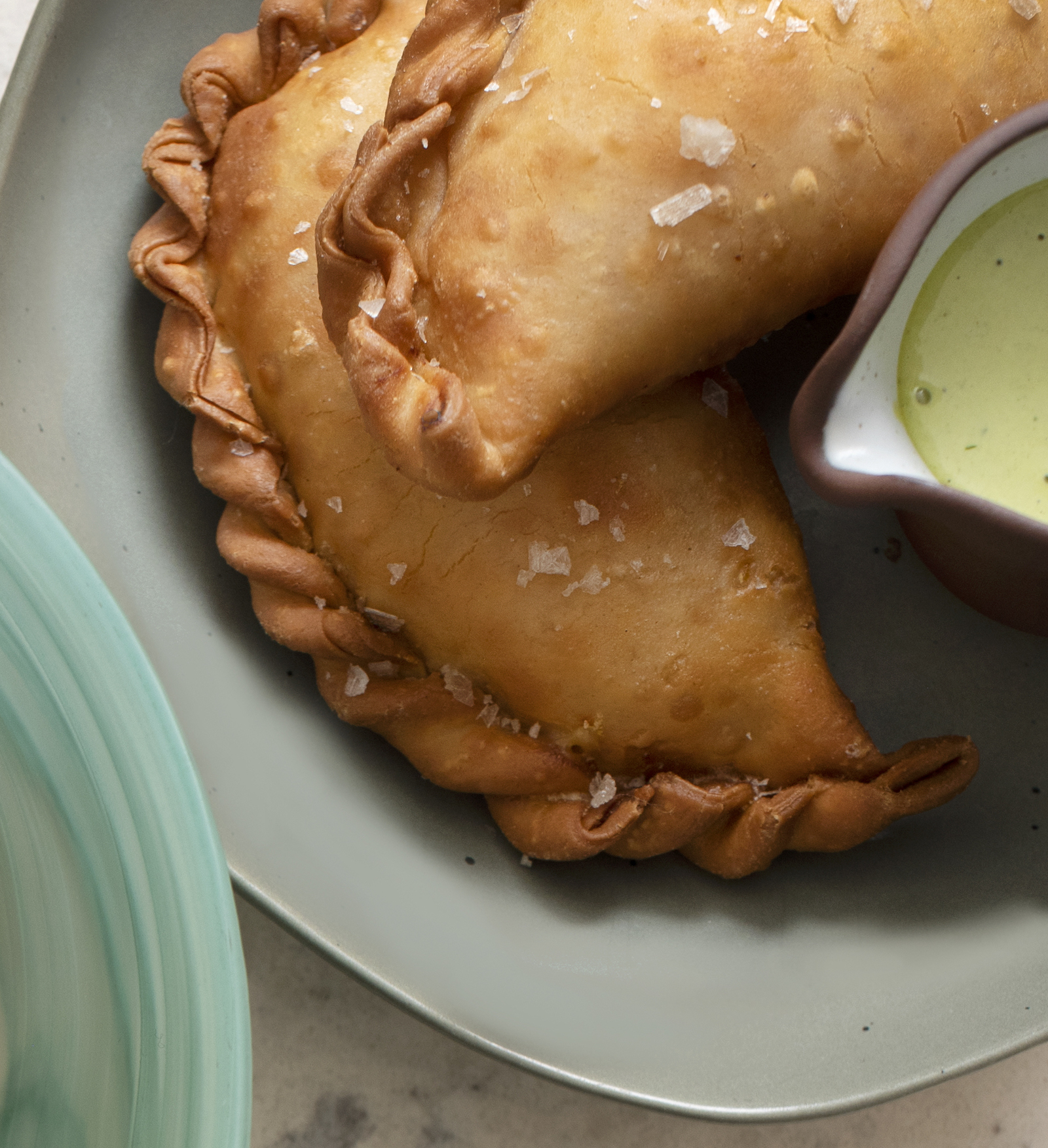Over the years, Santos has made a commitment to himself—and those who try his food—to honor his Mexican heritage by infusing the familiar flavors and culinary techniques he grew up with into his present-day cooking. An example of this at play is Santos’ famous pumpkin empanadas, which were inspired by some of the street food he would eat in Guadalajara.
We had the chance to catch up with chef Santos, who shared more about the importance of honoring one’s cultural traditions through food and how he does so on a daily basis at Flora Flora (and thousands of miles away from home). What’s more, the chef graciously shared the empanada recipe with us, so you can enjoy a bit of Gudadalajaran fare wherever you may be, too.
How chef Santos carries on his family’s traditions through food
According to Santos, many of the dishes at Flora Flora were inspired by his childhood in Mexico. “Growing up, the food I was accustomed to was simple and focused on highlighting the best characteristics of each individual ingredient we were using,” Santos says. That said, many of the traditional Guadalajaran dishes he would enjoy had “robust and bold flavors” paired with ample amounts of acid. “Not to mention enough spice to draw sweat as you’re eating,” Santos muses.
In Guadalajara, Santos tells us that Spanish colonizers and French merchants dating back centuries ago heavily influenced the unique flavors, culture, and gastronomy. One example of this influence is represented in one of the region’s most iconic dishes, which also happens to be one of Santos’s favorites: Torta Ahogada. “A Torta Ahogada is a sandwich made with salty French-style bread, filled with fried pork and refried beans, which is then dipped in a spicy tomato sauce and topped with lime-pickled white onions,” he says. Yum.

Santos says that while he has a deep appreciation for Guadalajaran cuisine, he has an even deeper appreciation for all traditions built in the kitchen. “In addition to drawing influence from specific ingredients, I am inspired by the environment my food curates. The way I cook and the dishes I prepare are best enjoyed in the company of one another—exactly how my family and I did,” Santos says.
“In addition to drawing influence from specific ingredients, I am inspired by the environment my food curates. The way I cook and the dishes I prepare are best enjoyed in the company of one another—exactly how my family and I did.”
—Samuel Santos, chef de cuisine at Flora Flora
From a young age, Santos’ mother helped spark his passion for high-quality, delicious food. “Growing up in Guadalajara as a child, as soon as I was able to gather 10 pesos, I would bike 15 kilometers [nine miles] to the fish market and buy myself half a dozen oysters. Applying my mom’s advice and wisdom on what to look for, I carefully circled around the market and deeply examined each stand to see where the freshest-looking oysters were and only made my purchase after heavily weighing all the options,” he says.
Looking back, Santos knows that his mother’s meticulous advice about oysters wasn’t the only influence she had on his relationship with food. “My mother is the reason I became a chef. She is the one that noticed how I behaved around food and how amused I was by it. She made sure to always find an opportunity to teach me about our gastronomic traditions,” he says. From a young age, Santos learned to make masa and tortillas—staples of Mexican cuisine—with the help of his mom, who instilled techniques and traditions that helped shape Santos into the talented chef he is today.
“My mother is the reason I became a chef. She is the one that noticed how I behaved around food and how amused I was by it. She made sure to always find an opportunity to teach me about our gastronomic traditions.”
The challenges of maintaining cultural authenticity in food when far away from home
Maintaining cultural authenticity in his cuisine is something that Santos strives to do at Flora Flora. That said, Santos says that he must adapt aspects of his cooking, at times, when miles and miles away from home. “It’s a unique challenge to recreate Mexican food with ingredients from another region, but this allows us to be creative and also to work with the best ingredients available in our area,” he says. For example, he uses sunchokes to make a creamy sauce (rather than guacamole) for their tequila-cured rockfish tostada as fresh, ripe avocados aren’t exactly available in Washington, DC in the winter.
“The uniqueness of Flora Flora is that we are recreating those flavors with ingredients that are grown and raised in the mid-Atlantic region,” Santos says. What’s more, the techniques he uses to prepare the dishes remain largely unchanged, and at the root of it are his Guadalajaran roots and traditions—and an arsenal of spices common to Mexican cuisine (especially the hot, tear-inducing ones).
Since Santos kindly shared his popular pumpkin empanada recipe with us, we asked him for a few tips and tricks for nailing it and the inspiration behind the dish. “The pumpkin empanadas are a merge of two of my favorite street cart foods that I grew up with, calabaza enmielada [candied pumpkin] and empanadas,” which Santos says are a typical dish served outside churches during Lent. Instead of taking a sweet approach to the dish, he gave them a savory twist by adding goat cheese and roasted pumpkin (instead of poaching in honey and piloncillo, aka cane sugar).
As for making them at home, Santos suggests letting them rest in the fridge for at least 30 minutes before frying or baking them, as it’ll help seal the dough so the edges won’t come undone while cooking. And like every chef will always tell you, taste as you go. “Taste the pumpkin filling every step of the way as you are making it. Feel free to deviate from the recipe by adding what you feel it needs. If you want to add some chiles for heat or more cheese or a different cheese like Chihuahua or mozzarella, do so. These are your empanadas,” he says.

Pumpkin empanada recipe
Yields 10 servings
Ingredients
Empanada:
1 pumpkin
1/2 cup goat feta cheese
1/2 cup coconut milk
1 cube of Japanese Golden Curry
1 empanada dough disc
1 Tbsp olive oil
Salsa Verde:
1 8-oz can of whole tomatillos
1 bunch of cilantro
1/2 white onion
1 Anaheim peppers
1 jalapeño peppers
4 cloves of garlic
1 Tbsp lime juice
Salt to taste
To make the empanadas:
1. For the pumpkin, I like using whichever is in peak season. I prefer the flavor of the Koginut, Kambocha, or Blue Hubbard. Whichever one you elect, the process will remain the same. Cut the pumpkin in half and take the seeds out. Reserve the seeds for later use. Sprinkle the inside of the pumpkin with salt.
2. Roast the pumpkin at 385°F for about 30-45 minutes or until the meat is tender. Once roasted, let the pumpkin sit out at room temperature until it’s cool to the touch.
3. While the pumpkin is cooling down. In a large pot, toast the reserved pumpkin seeds with olive oil for 5 minutes. Once toasted, add the coconut milk and the Japanese curry cubes and simmer for 10 minutes. Pass the coconut milk mixture through a strainer and set aside to cool down.
4. Remove the skin from the pumpkin and mash the pumpkin in a mixing bowl. Use about 4 cups of pumpkin and reserve the leftovers for later use. Mix the mashed pumpkin, goat feta, and the coconut milk mixture
5. To shape the empanadas, add some filling to each empanada and fold the dough over in half to enclose the filling. Use a fork to press and seal the edges closed. You can refrigerate the uncooked empanadas for up to 3 hours. To cook the empanadas, heat the oil to 350°F in a heavy bottom pot. Fry the empanadas until golden brown, 6 to 7 minutes.
To make the salsa verde:
1. Preheat the oven to 350°F. Large dice the onion, and for the peppers, remove seeds and membrane. Toss the onion, garlic, and peppers in oil and place on a roasting rack.
2. Once vegetables have been cooled down, place them in a blender with the rest of your ingredients and blend until smooth. Add salt to taste.
